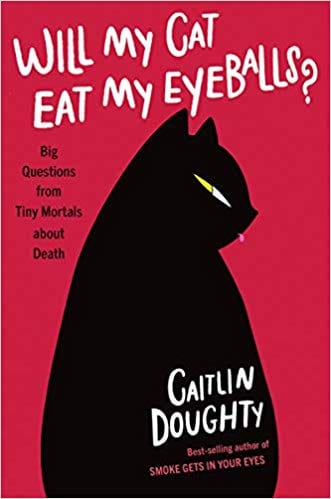 In “Will My Cat Eat My Eyeballs?” Caitlin Doughty, a mortician, encourages curiosity about death from readers of all ages. Drawing on science, personal experience and anecdotal evidence, she brings a lighthearted approach to questions that range from the practical to the absurd.
In “Will My Cat Eat My Eyeballs?” Caitlin Doughty, a mortician, encourages curiosity about death from readers of all ages. Drawing on science, personal experience and anecdotal evidence, she brings a lighthearted approach to questions that range from the practical to the absurd.
Doughty’s latest book may not be appropriate for readers navigating the challenges of a terminal illness or dealing with the fresh grief of losing a loved one. But for many, “Will My Cat Eat My Eyeballs?” serves to demystify the death process by treating it as a normal – even acceptable – part of life. Doughty based her book on questions from children because she finds them more direct, provocative and perceptive:
“It’s normal to be curious about death. But as people grow up, they internalize this idea that wondering about death is ‘morbid’ or ‘weird.’ They grow scared, and criticize other people’s interest in the topic to keep from having to confront death themselves.”
The questions range from the scientific (“What would happen to an astronaut body in space?”) to the practical (“If someone is trying to sell a house, do they have to tell the buyer someone died there?). Some (“Will I poop when I die?”) satisfy that trademark childhood curiosity, while others (“Can I be buried in the same grave as my hamster?”) reveal a touching bond with loved ones of all persuasions. Black-and-white illustrations by Dianné Ruz provide whimsical interpretations of these existential dilemmas, including the title question, “Will My Cat Eat My Eyeballs?”
A Mortician Steps in to Save the Day

Caitlin Doughty
Credit:dralvin.net
Doughty addresses each with humor and care, painting colorful scenes with memorable characters (Dr. Lisa, the unfortunate astronaut; Growler, the to-be-exhumed dog; and Gunther von Hagens, the “plastinator”). She delves into the scientific and legal reasons for her answers – such as abuse of corpse laws, which explain why people can’t hold onto their parents’ skulls. Children will appreciate the scientific integrity of her explanations as much as they are likely to revel in the humorous or gruesome nature of her subject matter. And there is much for adults to learn as well – what happens when you put a pacemaker in a cremation machine, the dubious origins of so-called “Viking funerals” and the standard depth of a grave in the U.S. (it’s not “Six Feet Under,” as a certain TV series might imply). As Doughty writes:
“We can’t make death fun, but we can make learning about death fun. Death is science and history, art and literature. It bridges every culture and unites the whole of humanity!”
Doughty is speaking from experience. She is also the author of “From Here to Eternity: Traveling The World In Search Of The Good Death,” in which she explores funerary practices in different cultures. And she founded The Order of the Good Death, an organization devoted to encouraging the acceptance of death.
If your curiosity has been piqued by the title, “Will My Cat Eat My Eyeballs?” you wouldn’t be the first one. But at the risk of a spoiler, the answer is – well, maybe.
To find out more, you’ll have to read “Will My Cat Eat My Eyeballs?: Big Questions From Tiny Mortals About Death” yourself.

 “Will My Cat Eat My Eyeballs?: Big Questions from Tiny Mortals About Death,” by Caitlin Doughty
“Will My Cat Eat My Eyeballs?: Big Questions from Tiny Mortals About Death,” by Caitlin Doughty


 John Mulaney’s “Funeral Planning” on Netflix: No Real Plan
John Mulaney’s “Funeral Planning” on Netflix: No Real Plan

 Composting Bodies Is Now Legal in a Dozen States
Composting Bodies Is Now Legal in a Dozen States














